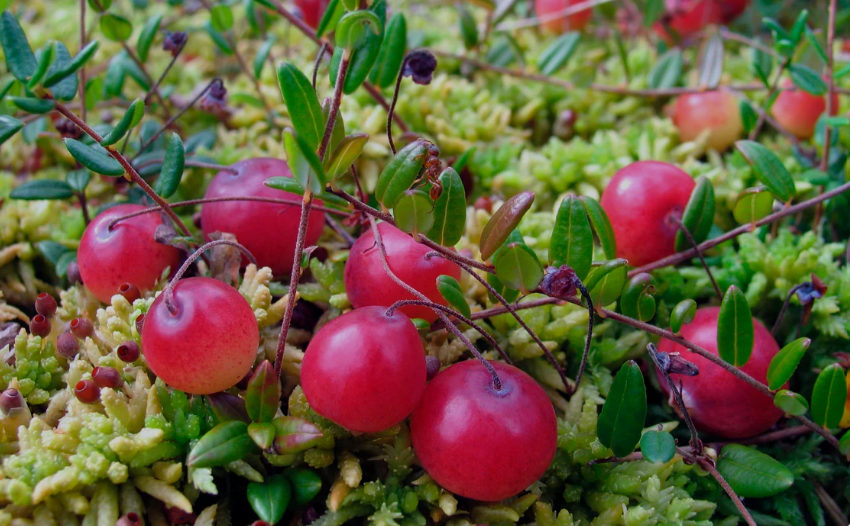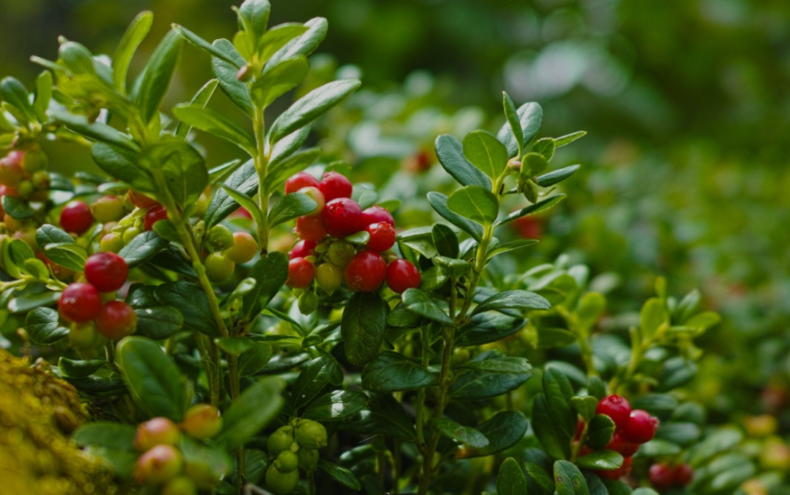
Cranberries are small, tart, red berries that grow on evergreen shrubs and trailing vines belonging mostly to the Vaccinium genus. They are native to cooler regions of North America, Europe, and Asia, where they thrive in acidic bogs and wetlands. The plants are hardy, able to withstand harsh conditions, and produce berries that ripen in late summer to autumn. While they are often associated with festive dishes and juices, cranberries also play an important ecological role, providing food for wildlife in their natural habitats.
These berries are rich in vitamin C, antioxidants, and phytonutrients that support immune function and protect the body against cell damage. They are particularly famous for their role in promoting urinary tract health, as certain compounds in the berries prevent bacteria from sticking to the urinary tract lining. Because of these benefits, cranberries have been used in both traditional remedies and modern health products, including juices, extracts, and dietary supplements.
Fresh berries are extremely tart, so they are often sweetened and cooked to make sauces, jams, or jellies. They are also commonly dried and used in cereals, baked goods, and trail mixes. Cranberry juice is popular worldwide, often blended with other fruit juices to balance its sharp flavor. Beyond sweet preparations, cranberries are also paired with savory dishes, especially meats like turkey and pork, where their acidity cuts through richness.
Cultivation of cranberries is most prominent in North America, particularly in the United States and Canada, which supply the majority of the world’s commercial harvest. Unique growing practices, such as the flooding of cranberry bogs during harvest season, make cranberry farming stand out. This method allows the berries, which contain air chambers, to float to the surface, making collection efficient. Over the centuries, cranberries have gone from wild foraged fruits to a staple of commercial agriculture, tied deeply to regional economies.

Cranberries
American Cranberry (Vaccinium macrocarpon)
The American cranberry, also known as the true or large cranberry, is native to North America and features large leaves and fruit that are less tart compared to other species. It produces dark red berries, though some varieties may yield pink or mottled red and white fruits.
The berries are about 6-8 mm in diameter, ripening in late summer and persisting into winter, offering a tart, astringent flavor ideal for sauces, jams, and traditional European dishes like lingonberry-style preserves. This self-fertile plant is generally resistant to pests and diseases, making it suitable for cultivation in USDA Zones 2-7, and it serves as a food source for both humans and wildlife.
European Cranberry (Vaccinium oxycoccos)
Vaccinium oxycoccos, commonly called the European or small cranberry, is a diminutive evergreen shrub distributed across the northern hemisphere’s peat bogs, moors, and acidic wetlands from Europe to Asia and North America. This trailing vine can spread up to 2 meters long and reaches heights of 5 to 20 centimeters, featuring slender, wiry stems that root at nodes and produce small, glossy, evergreen leaves that turn reddish in autumn.
Its pinkish-white flowers, resembling tiny cranes—hence the name “cranberry”—bloom in clusters during late spring to early summer, giving way to tart, juicy berries that ripen from green to deep red by fall.
Small Cranberry (Vaccinium microcarpum)
The small cranberry, Vaccinium microcarpum, is a compact, creeping evergreen shrub akin to its European relative, native to the cold, acidic mires and tundras of northern Europe, Asia, and parts of North America, where it forms dense mats in sphagnum bogs.
Reaching only 5-10 cm in height with trailing stems up to 30 cm long, it features triangular, small leaves with curled margins and sparse, wheel-shaped pinkish-white flowers in terminal clusters during June-July. Its namesake fruits are minute, pale pink to red berries, under 1 cm across, with a sharp, acidic taste that matures by August-October, often used in Scandinavian and Russian cuisines for relishes or teas due to their high acidity and nutritional profile.
Southern Mountain Cranberry (Vaccinium erythrocarpum)
Vaccinium erythrocarpum, or southern mountain cranberry, is a deciduous shrub endemic to the high-elevation ridges and slopes of the southern Appalachian Mountains, from West Virginia through Georgia, thriving in rocky, acidic woodlands at 1,000-1,800 meters. Growing 1-2 meters tall with upright branches, it displays alternate, elliptic leaves with finely serrated edges that turn brilliant red in fall, complemented by clusters of small, urn-shaped white-to-pinkish flowers in June-August.
The berries, its hallmark, are large, glossy dark red drupes up to 1 cm wide, ripening mid-summer with a mild, sweet-tart flavor reminiscent of huckleberries, earning it the alias “red huckleberry” among foragers.
Mountain Cranberry or Lingonberry (Vaccinium vitis-idaea)
Lingonberry, Vaccinium vitis-idaea, is a low, evergreen understory shrub widespread in boreal forests, tundras, and acidic heaths across the Northern Hemisphere, from Scandinavia to Alaska and the Pacific Northwest. Forming mats 10-40 cm tall with wiry, rounded stems and leathery, dark green leaves that roll under in winter for protection, it bears terminal clusters of small, bell-shaped pinkish-white flowers in early summer, followed by tart, bright red berries that persist through frost.
These pea-sized fruits, harvested from August to November, boast intense flavor for jams, sauces, and pies, packing high levels of vitamin C and antioxidants, and are a staple in Nordic cuisine.
Ben Lear
Ben Lear is an early-ripening heirloom cranberry cultivar, selected from a wild Wisconsin clone in 1901 and revived for commercial propagation due to its vigorous growth and high productivity. This low-growing, trailing evergreen shrub reaches 15-20 cm tall, spreading up to 1 meter with wiry stems and small, glossy leaves that provide year-round interest.
Pinkish-white flowers in late spring yield medium-to-large, deep burgundy-red berries by late September, noted for their firm texture, tart flavor, and excellent storage qualities, making them suitable for fresh markets, juices, and processing.
Crimson Queen
Crimson Queen, a 2006 Rutgers hybrid of Stevens and Ben Lear, excels with early blooming and ripening, yielding larger, vibrant red fruits with higher sugar content and better color than older varieties. Its vigorous growth habit allows for rapid bog coverage and consistent harvests exceeding 300 barrels per acre.
Resistant to some fruit rots, it’s suited for commercial production in zones 3-7, thriving in moist, acidic soils (pH 4.3-5.2). This cultivar enhances fresh market appeal with its firm texture and extended shelf life, making it a favorite for sustainable cranberry operations.
Early Black
Early Black, one of the oldest cultivated cranberry varieties dating to the mid-19th century in Massachusetts, is prized for its precocious ripening and robust flavor profile. This trailing evergreen shrub forms dense mats 10-15 cm tall, with blunt-tipped, dark green leaves that redden in autumn, and clusters of small pinkish flowers blooming in May-June.
Berries emerge bright red, maturing to deep purple-black by late August—before frost—offering small-to-medium fruits with intense tartness, high aroma, and juicy texture perfect for traditional relishes and pies.
Franklin
Franklin, a hybrid cross of Early Black and Howes from the University of Massachusetts, Named after cranberry pioneer H.J. Franklin, it’s a staple in New England processing, contributing to hybrids like NJS98-34. Growing as a compact, evergreen trailer to 15 cm tall and spreading via short runners, it has fine-textured, light green leaves and upright fruiting shoots bearing pink flowers in early summer.
Medium-sized, glossy dark red berries ripen early to mid-season, featuring firm flesh, more seeds for texture, and balanced tart-sweet notes that store exceptionally well, resisting rot better than many heirlooms. Ideal for zones 3-7 in moist, acidic conditions (pH 4.0-5.0), it produces steady yields with few runners, easing management in bogs, and shows strong resistance to false blossom disease.
Howes
Howes, selected in 1843 from a Massachusetts wild stand, is a late-season heirloom renowned for frost-hardy, firm berries that excel in storage and transport. This evergreen creeper reaches 20 cm high with varied growth—upright shoots and long stolons—small light green leaves, and pink blooms in June leading to shiny, large red fruits ripening October-November.
With low titratable acidity and resistance to fruit rot, the berries offer crisp texture for fresh eating or juicing, though susceptible to false blossom. Thriving in zones 2-7 on acidic, sandy loams (pH 4.3-5.2) with full sun, it yields well in cooler climates like the Pacific Northwest, influencing hybrids for quality.
McFarlin
McFarlin, discovered in 1874 on a Massachusetts farm and named for its propagators, is a classic large-fruited heirloom celebrated for productivity and flavor in both fresh and processed markets. This vigorous trailing vine grows 15-20 cm tall, spreading widely with wiry stems, oval evergreen leaves, and nodding pink flowers in clusters during May.
Large, round, dark red berries—up to 1.5 cm—ripen mid-to-late season, featuring thick skins for longevity, juicy tart flesh, and no aroma, perfect for relishes and exports. Adapted to zones 2-7 in full sun and peaty bogs (pH 4.0-5.5), it bears heavily—often 250+ barrels per acre—with good frost resistance, though prone to splitting in wet falls. As a parent to Stevens and others, McFarlin shaped modern breeding for size and quality, dominating Pacific Northwest plantings historically.
Pilgrim
Pilgrim, a mid-20th-century hybrid of McFarlin and Prolific, earns acclaim for oversized, vibrant berries and late ripening suited to extended harvests. Forming low evergreen mats 15-18 cm high and 60-90 cm wide, it sports dense green foliage turning reddish in cold, with profuse pinkish-white flowers attracting butterflies in spring.
Exceptionally large, nickel-sized deep red fruits emerge late September, boasting tart richness, firm texture, and easy mechanical harvest, yielding high in commercial settings. Hardy in zones 2-7 with acidic, moist soils (pH 4.0-5.0) and full sun, it tolerates wet feet while resisting some rots.
Stevens
Stevens, a 1950s hybrid of McFarlin and Potter from Wisconsin, revolutionized cranberry farming with high yields and disease tolerance. This spreading evergreen reaches 15 cm tall, with fine vines, small leaves, and pink flowers yielding medium-large, bright red berries mid-season—known for flavor, anthocyanin, and rot resistance.
Suited to zones 2-7 in sunny acidic bogs (pH 4.3-5.2), it produces 300+ barrels per acre, influencing countless hybrids. Versatile for processing, it’s a bog staple, offering winter cover and wildlife habitat.
Mullica Queen
Mullica Queen, a 2008 Rutgers release from Lemunyon and #35 crosses, excels in yield and color with diverse native genetics from Massachusetts, New Jersey, and Wisconsin. Trailing to 20 cm with vigorous runners, it features evergreen leaves and early flowers producing large, round red berries by mid-September—high anthocyanin, moderate acidity, and rot resistance boosting productivity to 320 barrels per acre.
For zones 3-7 in moist acid soils (pH 4.0-5.5), its thick stems withstand harvest, flowering 3-5 days ahead of Stevens. A commercial powerhouse, it enhances fresh and processed markets while aiding bog ecology.
Demoranville
Demoranville, a Rutgers hybrid echoing Early Black and Howes lineages, shines with early color, large fruits, and high yields for premium production. Low-growing evergreen with dense foliage, pink blooms lead to ovate, vivid red berries ripening early—exceptional anthocyanin, low acidity, and vigor yielding over 300 barrels per acre.
Thriving in zones 2-7 on acidic wet sites (pH 4.0-5.2), it resists rots and establishes fast, named for cranberry expert Carolyn DeMoranville. Valued in modern bogs, it supports sustainable farming and wildlife.
GH1
A newer hybrid from Wisconsin, GH1 is characterized by its high productivity and large, firm berry size. It was developed to thrive in the Midwest’s growing conditions and has excellent winter hardiness, making it a valuable cultivar for northern bogs.